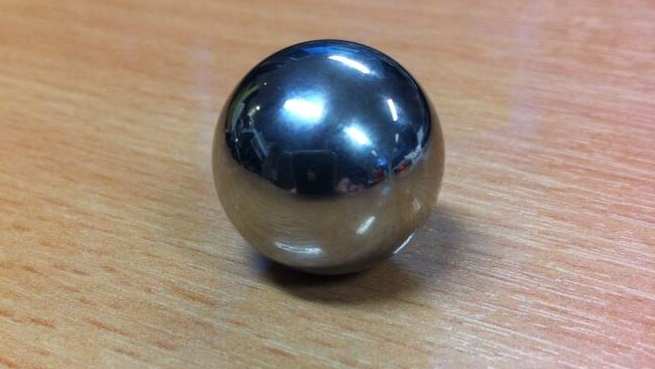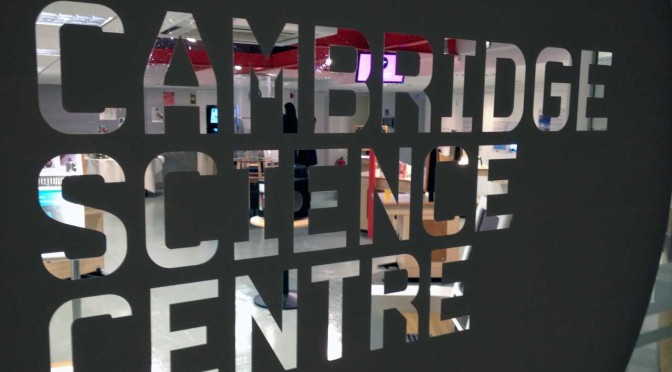Our film, Demo: The Movie, touches on ideas about how to teach science, but Jonathan and I would really love to make a documentary with the title “How Should We Teach Science?” Alex Bellos is a populariser of maths who’s been lucky enough to make a Radio 4 documentary exploring how maths is taught in our schools today and looking at the science and evidence which supports different approaches. We’re jealous. You can listen to it by clicking here.
Eddy currents
Alom and I are filming at the moment, hence things being rather quiet around here. However, the above caught my eye. This demo is typically done with a long length of copper pipe, and the magnet takes many seconds to fall through. It’s effective on a stage.
The tall narrow pipe, however, is precisely the wrong shape to film, and on video the demo doesn’t work so well. This shorter length of fatter pipe, with an appropriate magnet, has more impact on camera.
Same principle, same demo… but different treatments for different audience contexts. So, lessons for us all:
- Don’t assume that the way you’ve seen a demo performed is the best way. Always look for improvements.
- It’s not just the demo that matters, it’s the way you use it.
That separation of ‘content’ and ‘treatment’ is, for me, an absolutely key concept.
Tip of the hat to my dad for sending this in.
Stage fright
Over the years I have spent a lot of time training science presenters. I’ve seen the best part of a full spectrum: Those calm cucumbers who get up on stage without a second thought, and those who are virtually paralysed with fear. Every time.
I have learned that you can’t always tell the latter from the former with any real degree of accuracy until there are just the two of you in rehearsal before an audience walks in the door. Sometimes the cool ones crumble.
Today, I spent some time in our theatre with a new recruit who will soon start treading the boards for herself. When I started describing the different techniques to keep the jitters in check, perhaps even turn them into a positive force, she told me about this recently uploaded TED talk.
That’s one, mighty clever way to put a positive spin on stage fright.
The gloves conundrum
UCL chemist and demonstrator extraordinaire Andrea Sella, on his blog:
the wearing of gloves in the lab may, counter-intuitively, put us, our students, and our fellow lab workers at greater risk than riding their flasks bearback.
Do read the rest of his post, and likely the rest of his blog too.
I should talk to CLEAPSS about this sometime – Andrea’s comments on gloves make a lot of sense to me, but I’ve no idea what the standing advice for schools is. Ah, the simple life of not actually being a teacher.
Group theory and Rubik’s Cube
We can talk about maths here, right? Well hey, I guess it’s me that makes the rules, so: yes, we can talk about maths here.
http://www.youtube.com/watch?v=FeVysczKR_k
You’ll have to crank up the volume, but it’s worth it: Katie Steckles‘ description of group theory and Rubik’s Cubes is as good as any I’ve seen. Better, in fact, in that for the first time in 30 years of cubing I think I understood it this time.
…and believing you understand something is the same as understanding it, yes? Oh no, wait: this site draws the line at philosophy. Drat.
Cake-stand magnetometer
With patience and a bit of wiggling, you can detect the magnet from nearly nearly three metres away. Which is astonishingly sensitive for a cake stand.
TV presenter & props chap Marty Jopson built a magnetometer using a laser pointer, a fridge magnet, and an Ikea cake stand. It was used a few weeks ago on BBC Stargazing Live.
(via Marty on Twitter).
Precision vs pedantry
Over the last few years, making all these demo films, I’ve found myself thrust back into the world of school education. It’s a bit of a shock. I’m young enough to have taken GCSEs myself, but old enough to have been in the first year to sit them. Much has changed.
One thing I find slightly baffling is the obsession with extremely precise terminology. There’s a natural inclination to precision in the sciences, but some of what I’ve seen veers towards the obsessive. It’s not precise, it’s pedantic. And it’s nerve-wracking. I can’t write a sentence of script without the fear of somehow mis-stepping, of treading on some unseen toes and bringing down some unrelenting diatribe about how you can’t use that specific word there, only this one.
Now, I’m old enough and weary enough to battle through such pressures. There are also times when I can dimly recall enough of the physics I once did to be reasonably certain that not all of the advice I receive is… umm… correct.
But if I find myself staring at an explanation with that stomach-knotting dread of you’re doing it wrong, how is a twelve year-old supposed to cope? Respect due, we’re raising them tough these days.
My assumption is that pedantry has crept in because it’s quicker and easier to assess whether the student can recite rote-learned material accurately than it is to judge their understanding against the examiner’s (also-flawed/incomplete?) knowledge.
But that really is an assumption. So, some questions:
- Am I right that school science is increasingly pedantic?
- Does being able to parrot a very particular definition demonstrate understanding?
- …or am I falling into the category of “people who don’t know much about education, but inexplicably think their opinion has some value anyway”?
Chain Reaction: Cambridge
http://vimeo.com/80795157
I’m a bit of a fan of the Cambridge Science Centre, and of the people behind it. A year ago I trekked down from Newcastle to help them fix things up just before they opened. So by ‘fan’ I mean ‘groupie.’
Hence, my favourite parts of this film are Chris Lennard saying ‘Heath-Robinson‘ rather than ‘Rube Goldberg‘ (quite right too), and the brief glimpse at the end of the inimitable Dave Ansell leaning in to blow out a candle. Lovely people all.
My biggest problem with Heath Robinson machines is that they’re impossible to photograph unless they’re designed specifically for the camera. And the only people to have done that, really, are the folks behind the magnificent Japanese children’s series Pitagora Suichi, whose mechanisms are unbelievably smart:
http://www.youtube.com/watch?v=HSf-3gwHPZA
(check this playlist for a bunch more from the same source.)
Mile of π
You need more π? We got more π: Mile of π download, at Think Maths. A printable version of everyone’s favourite transcendental number, ideal for classroom or general decorative use.
The black holes have arrived!

I’ve ordered a handful of 18mm steel ball bearings for a demo that isn’t a demo, it’s merely a handling object, but handling objects can also have power and impact.
Hold out your hand and feel the weight of this ball on your palm. It’s pretty heavy. The metal is dense. Now imagine the impossible.
Imagine that all of this room is squashed and squeezed into the ball. It’s pretty tightly packed and much more dense. Now imagine the whole building is inside this ball. Hardly conceivable, but we’re not there yet. The stuff we’re made of contains lots of gaps – tiny gaps we can’t see, but gaps nonetheless. If all those gaps were filled in with more stuff we could squeeze even more mass into the ball. The whole city. The country. The entire world.
If the whole Earth, everything in it and everyone on it, were so densely packed that it could fit inside this steel ball, it would be a black hole. So dense that nothing could escape the pull of gravity.
It’s incredible how powerful something can be when brought down to an intimate, handle-able size.
The Earth has a Schwartzchild radius of 9mm. If the Earth was a black hole it would comfortably fit inside my wedding ring. That’s amazing.
Footnote: Please make sure you read Dave Ansell’s comment below. We’re not aware that any black holes the mass of the Earth exist. Black holes with larger mass would not need to be so dense.


